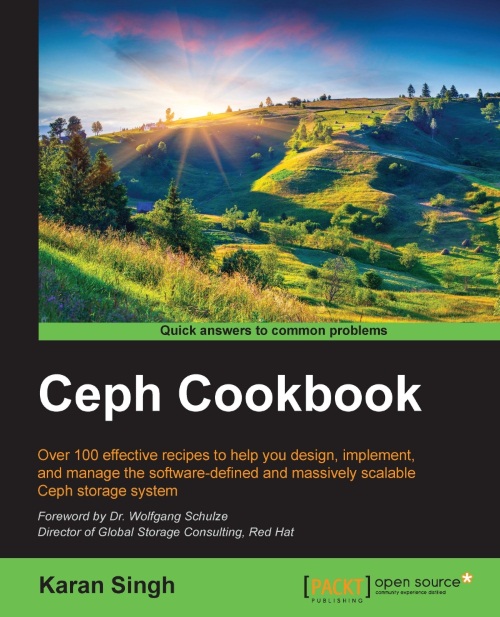Ceph is a massively scalable, open source, distributed storage system whose key ingredients are an object store, a block store, and a distributed file system.
Karan Singh, a system specialist of storage and cloud for CSC – IT Center for Science Ltd., wants to help you put them all together.
He wrote this new cookbook to provide quick answers to common questions about Ceph — which was created by OpenStack gold member DreamHost and is the storage system currently used by CERN. (If you’re coming to the Austin Summit, check out these sessions on how users like Bloomberg are employing Ceph.)
The 326-page book serves up 100 recipes to help you design, implement and manage the software-defined storage system. The paper edition retails for $35.99 but Packt Publishing offers a 50 percent discount on the ebook version, just use the promo code "CEPH50" at checkout.
Superuser asked Singh about the "Linux moment" for storage, common mistakes people make with Ceph — and his favorite meal to write by.

Your blog slogan is “Where there’s a cloud, there’s a way!!” how does that play out in your daily work?
I’ve worked with variety of systems ranging between hardware defined solutions to software defined solutions. With cloud, the rate of adoption of technology and innovation has significantly increased. In the past, I have seen standard IT requests taking weeks to fulfill, but now with cloud it’s all self serviced in a few clicks. That’s the quality of IT that I enjoy today and it’s all because of cloud.
Cloud is no longer a hyped buzzword, it’s a practical approach an organization must adopt for their competitive long-term survival. If they don’t want to become extinct, they must adapt.
Who will this help most?
This book is aimed at storage and cloud system engineers and administrators, technical architects and consultants who are interested in building software-defined storage solutions using Ceph to power their cloud and virtual infrastructures.
It has now become a fact that Ceph is the most popular storage backend for OpenStack, so this book is also for OpenStack operators / administrators to help them build their successful deployments of Ceph.
What are some of the most common mistakes people make with Ceph?
The most common mistake that people make with Ceph is they don’t design their cluster for what they need, and the irony is that then they expect the cluster to fulfill their needs…
Ceph is like WYDIWYG (What You Design Is What You Get )— so one should meticulously design their Ceph cluster for IOPS, throughput or capacity. The book goes into these different design approaches in detail.
Is storage having its Linux moment?
If we go back in time, we see that technology has gone through a serious makeover. The growth of closed source and proprietary solutions has been declining and organizations are interested in open-source alternatives. What Linux did in last two decades in the operating system world is what Ceph has started doing in SDS industry. So, the storage industry is clearly having its Linux moment. Whether proprietary storage players realize or not but they are soon going to be endangered species due to software defined storage wave. And Ceph definitely has a bigger share of this wave.
Why is a book helpful now — there’s IRC, mailing lists, documentation, your own video tutorials etc.?
Well, for me, the priority to look for help goes like this: documentation, book, mailing list, IRC and discussions with people. Books, being the classic form of knowledge, are still a popular choice to start learning about the subject in detail. The good part about a book is that it’s self- contained, sequential, incremental and easy to refererece. The Ceph CookBook talks about the technology in a way that’s useful for beginners to advanced readers. It explains how things work under cover, how to get your tasks done and answers to common problems.
What’s on your OpenStack bookshelf?
And what’s the “missing manual” you’d like to see?
I would like to see user stories and their experiences in running Ceph as storage backend for their container infrastructure as well as large scale CephFS deployments.
What was your favorite meal while writing the book?
It’s really hard to choose one out of several best, I hope my wife is reading this and noticing that I just said ‘several best’ 🙂
But anyway, my personal favorite is homemade Indian bread with creamy spinach cheese curry. I think I should write a cookbook for this as well.
Cover Photo// CC BY NC
- Demystifying Confidential Containers with a Live Kata Containers Demo - July 13, 2023
- OpenInfra Summit Vancouver Recap: 50 things You Need to Know - June 16, 2023
- Congratulations to the 2023 Superuser Awards Winner: Bloomberg - June 13, 2023

)










